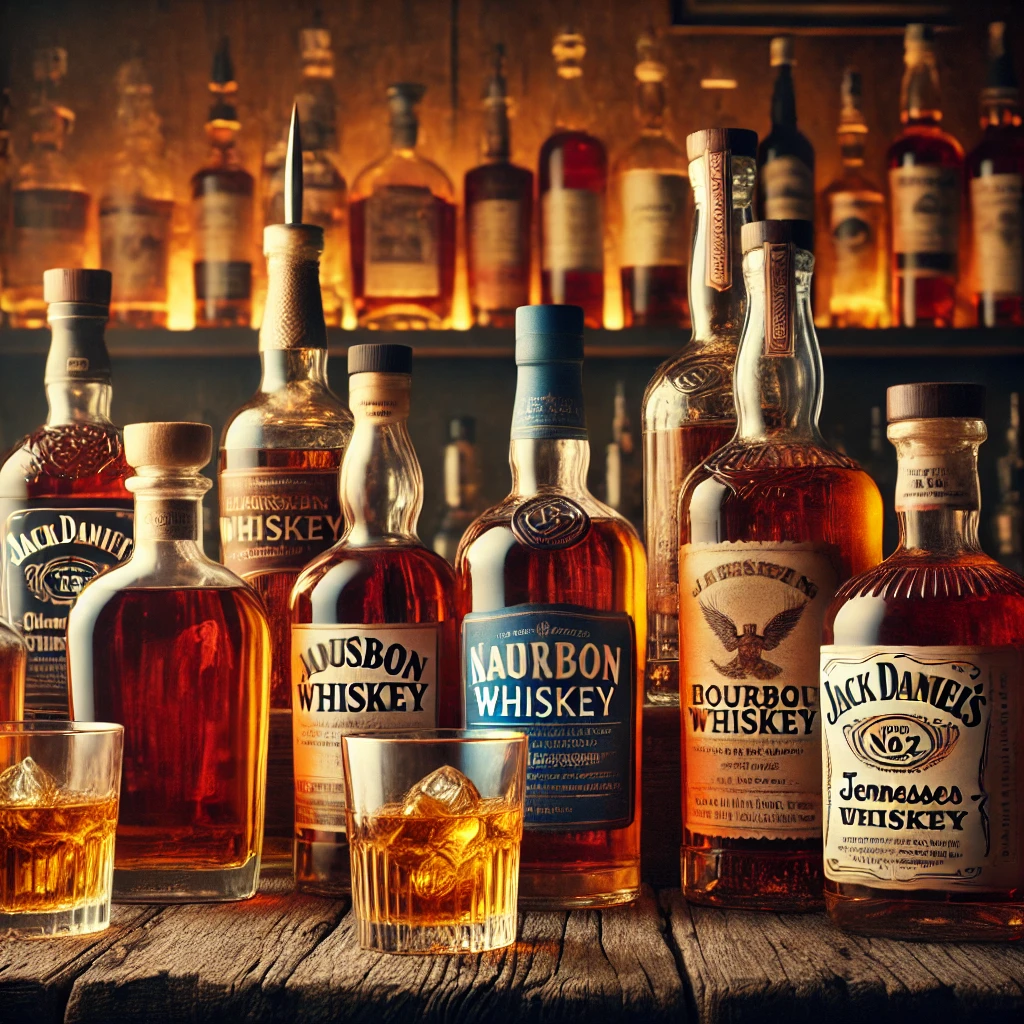WHAT ABOUT BOURBON

Bourbon has a rich history deeply intertwined with American culture, particularly in Kentucky, where it originated. While whiskey production dates back centuries, bourbon is uniquely American, with its roots tracing back to the late 18th century.
Origins (1700s – Early 1800s)
- Settlers, many of Scottish, Irish, and German descent, brought distillation techniques to the American frontier, particularly Kentucky and Tennessee.
- Kentucky’s natural limestone-filtered water, which removes iron impurities, made it an ideal location for whiskey production.
- Corn, abundant in the region, became the primary grain, leading to the distinct taste of bourbon.
- The name “Bourbon” is believed to have come from Bourbon County, Kentucky, named after the French Bourbon dynasty.
Rise in Popularity (1800s)
- Elijah Craig, a Baptist minister and distiller, is often credited with aging whiskey in charred oak barrels, a defining characteristic of bourbon.
- In the early 19th century, bourbon was transported down the Ohio and Mississippi Rivers to New Orleans, where its popularity grew.
- The Bottled-in-Bond Act of 1897 established regulations ensuring quality and authenticity in whiskey production.
Prohibition and Revival (1900s)
- The Prohibition era (1920-1933) nearly destroyed the bourbon industry, though some distilleries obtained licenses to produce whiskey for medicinal purposes.
- After Prohibition ended, bourbon slowly regained its prominence, particularly with brands like Jim Beam and Maker’s Mark leading the way.
Modern Bourbon Boom (2000s – Present)
- The late 20th and early 21st centuries saw a resurgence in bourbon’s popularity, driven by craft distilleries, premium small-batch releases, and global demand.
- Today, bourbon is a multi-billion-dollar industry, with distilleries experimenting with aging techniques, mash bills, and finishes.
Defining Bourbon Today
- By U.S. law, bourbon must:
- Be made in the U.S.
- Contain at least 51% corn.
- Be aged in new, charred oak barrels.
- Be distilled to no more than 160 proof and entered into the barrel at no more than 125 proof.
- Be bottled at a minimum of 80 proof (40% ABV).
Bourbon continues to be a cultural icon, deeply tied to Kentucky’s heritage but enjoyed worldwide.
Bourbon comes in several styles, each with unique characteristics based on the mash bill, aging process, and production techniques. Here are the main styles of bourbon:
1. Traditional
- Mash Bill: Typically 70-80% corn, with the remainder being rye and malted barley.
- Flavor Profile: Well-balanced, caramel, vanilla, oak, and spice.
- Examples: Jim Beam, Buffalo Trace, Evan Williams.
2. High-Rye Style
- Mash Bill: Contains a higher percentage of rye (usually 20-35%) along with corn and barley.
- Flavor Profile: Spicier, bolder, with notes of pepper, baking spices, and a drier finish.
- Examples: Bulleit Bourbon, Old Forester, Four Roses Single Barrel.
3. Wheated Style (Wheater)
- Mash Bill: Uses wheat instead of rye as the secondary grain (along with corn and barley).
- Flavor Profile: Smoother, softer, with sweeter notes of honey, caramel, and butterscotch.
- Examples: Maker’s Mark, W.L. Weller, Pappy Van Winkle.
4. Bottled-in-Bond
- Legal Requirement: Must be aged at least 4 years, bottled at exactly 100 proof, and produced in a single distilling season at one distillery.
- Flavor Profile: Rich, full-bodied, and robust due to the higher proof.
- Examples: Old Grand-Dad Bonded, Heaven Hill Bottled-in-Bond.
5. Single Barrel
- Production: Comes from a single aging barrel rather than a blend of multiple barrels.
- Flavor Profile: Unique from barrel to barrel, often richer and more complex.
- Examples: Blanton’s, Four Roses Single Barrel, Elijah Craig Single Barrel.
6. Small Batch
- Production: Made by blending a limited number of barrels to maintain a distinct, high-quality flavor profile.
- Flavor Profile: More refined and consistent than single barrel but still complex.
- Examples: Knob Creek, Basil Hayden’s, 1792 Small Batch.
7. Cask Strength (Barrel Proof) Style
- Production: Bottled directly from the barrel without dilution, often above 110 proof.
- Flavor Profile: Intense, bold, and full-bodied, with strong oak, spice, and caramel notes.
- Examples: Stagg Jr., Elijah Craig Barrel Proof, Booker’s.
8. Finished Style
- Production: Aged in traditional bourbon barrels but finished in secondary casks (e.g., sherry, wine, rum barrels).
- Flavor Profile: Unique layers of flavor, often fruitier or richer due to secondary aging.
- Examples: Angel’s Envy (port finish), Belle Meade (sherry finish), Woodford Reserve Double Oaked.
Each style of bourbon offers a different drinking experience.
Blended bourbon is a type of bourbon whiskey that consists of a mix of different bourbon whiskeys or a blend of bourbon with other neutral grain spirits. However, there are two main categories of blended bourbon:
1. Blended style Bourbon Whiskey (with 51% Minimum)
- Must contain at least 51% straight bourbon (aged at least two years).
- The remaining percentage can include other whiskey, neutral grain spirits, or additives (like caramel coloring or flavoring).
- Often used in lower-cost or mass-market bourbons.
2. Blended Straight Bourbon Whiskey
- A blend of only straight bourbons from different barrels, distilleries, or batches.
- No neutral grain spirits or additives allowed.
- Typically used to create a consistent or unique flavor profile.
Blended bourbons can range from affordable, easy-drinking options to premium blends crafted for complexity. Are you looking for a recommendation based on flavor or price?
Flavored bourbon is bourbon whiskey that has been infused with natural or artificial flavors, such as honey, vanilla, cinnamon, fruit, or spices. While it starts as bourbon, once flavors are added, it no longer meets the legal definition of straight bourbon and is classified as a flavored whiskey instead.
Key Features of Flavored Bourbon:
- Base Spirit: Made with bourbon whiskey as the foundation.
- Added Flavors: Common flavors include honey, cinnamon, cherry, vanilla, apple, and maple.
- Lower Proof: Often bottled at a lower alcohol content (typically 60-80 proof) compared to traditional bourbons.
- Sweeter & Milder: Designed for easy drinking, often appealing to those new to whiskey.
Flavored bourbons are great for sipping neat, on the rocks, or in cocktails. Do you have a specific flavor you’re interested in?
Vintage bourbon refers to bourbon that is either:
- Older, discontinued bottles from past decades (also called “dusties”).
- Bourbons released with a vintage year, indicating the year it was distilled or bottled.
1. Dusty (Old/Discontinued) Bourbon Bottles
- These are bottles from past decades (e.g., 1940s-1990s) that are no longer in production.
- Some are highly sought after by collectors due to changes in production methods, aging, or mash bills.
- Examples include:
- Pre-Prohibition bourbons
- Old bottles of Old Grand-Dad, Wild Turkey, or Stitzel-Weller bourbons
- Early versions of Pappy Van Winkle
2. Vintage-Dated Bourbon
- Some distilleries release bourbons with a specific vintage year, similar to wine.
- The vintage year often reflects the distillation or bottling date.
Why Do People Seek Vintage Bourbon?
- Older bottles often have unique flavor profiles due to past production methods.
- Some vintage bourbons were made with different grain sources or distilling techniques.
- Collectors and enthusiasts enjoy tracking down rare bottles for drinking or investment.
What about Jack Daniels?
No, Jack Daniel’s is not officially classified as bourbon—it is a Tennessee whiskey. While it meets the legal requirements to be called bourbon, Jack Daniel’s undergoes an additional process called the Lincoln County Process, which sets it apart.
Lincoln County Process – Before aging, the whiskey is filtered through charcoal made from sugar maple wood. This charcoal mellowing process removes impurities and gives the whiskey a smoother character.
- Tennessee Whiskey Classification – Tennessee law requires this extra filtering step, which differentiates it from bourbon.
- Self-Identity – Jack Daniel’s has always marketed itself as Tennessee whiskey, not bourbon, to maintain its distinct identity.
The Manhattan is a classic bourbon cocktail. For more on bourbon, follow the link.
